Deserts hot Sahara
- Books Name
- Social Science Book
- Publication
- Cognizance Publication
- Course
- CBSE Class 7
- Subject
- Social Science
Chapter 9
Life in the Deserts
A desert is barren area of landscape where little precipitation occurs and consequently, living conditions are hostile for plant and animal life. Extreme temperatures combined with little rainfall make desert life difficult for people, plants and animals.
Desert- Desert is an arid region characterised by extremely high or low temperature and has scarce vegetation. Depending on the temperatures that can be hot deserts of cold deserts.
The Hot Desert-Sahara
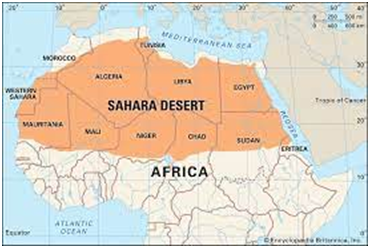
Sahara is the world's largest desert. It has an area of around 8.54 million sq km. The Sahara desert touches 11 countries- Algeria,Chad, Egypt, Libya, Mali, Mauritania, Morocco, Niger, Sudan, Tunisia and Western Sahara. Beside the vast stretches of sand, the Sahara desert is covered with, gravel plains and elevated pleateaus with bare rocky surface. These rocky surfaces maybe more than 2500m high at some places.
Temperature and Climate
The climate of Sahara desert is scorching hot and parch dry. It has a short rainy season. The sky is cloudless and clear. Here,the moisture evaporates faster than it accumulates. The temperature during the day may soar as high as 500 C, heating up the sand and the barerocks,which inturn radiates heat, making everything around hot. The nights may be freezing cold, with temperatures nearing zero degrees.
Scientists have actually found skeletons of fish in this desert.
Rainforest (Flora and Fauna)
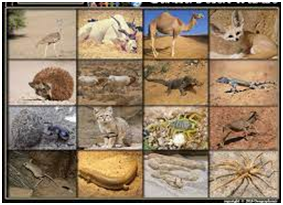
Desert vegetation includes cactus, date palms, and acacia. In some places there are oasis- green islands with date palm surrounding them. Camels, hyenas, jackals, foxes, scorpions, many varieties of snakes and lizards are the prominent animals species living there.
Present day Sahara once used to be lush green plain. Cave paintings in Sahara desert show that there used to be the rivers with crocodiles, elephants, lions, giraffes, ostriches, sheep, cattle and goats were common animal, but the change in climate has changed it to very hot and dry region.
Al Azizia in the Sahara Desert, south of Tripoli, Libya recorded the highest temperature of 57.70C degree in 1922.
People
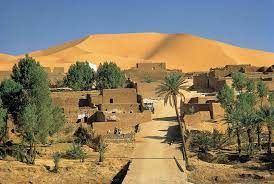
The Sahara desert has been inhibited by various groups of people, who pursue different activities. Among them are Bedouins and Tuaregs, who are nomadic tribes, rearing livestock such as goats, sheep, camel and horses. These animal provide them with milk, hides from which they make leather for belts, slippers, water bottles; hair is used for mats, carpets, clothes and blankets.They wear heavy robes as protection against the storms and hot winds.
The Oasis in the Sahara and the Nile Valley in Egypt supports settled population. Since water is available, the people grow date palms. Crops such as rice, wheat, barley and beans are also grown. Egyptian cotton, famous worldwide, is grown in the Egypt. The discovery of oil is constantly transforming the Sahara desert. Other minerals found in area include Iron, phosphorus, manganese and uranium. The cultural landscape of the Sahara is undergoing change. Gleaming glassed case office buildings, towers over mosques and superhighways crisscross the ancient camel path. Trucks are replacing camels in the salt trade. Tuaregs are seen acting as guides to foreign tourists. More and more nomadic herdsmen are taking to city life, finding jobs in oil and gas operations.
Depressions are formed when the wind blows away. The sands in the depression where underground water reaches the surface, an Oasis is formed. These areas are fertile.People may settle around these water bodies and grow date palms and other crops.Sometimes the overseas, maybe abnormally large. Tafilalet Oasis in Morocco is a large oasis with an area of about 13,000 sq km.
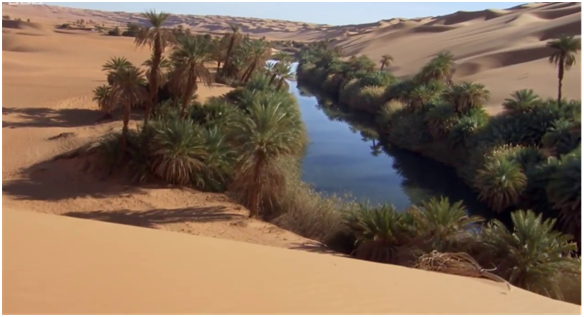
Deserts cold Ladakh
- Books Name
- Social Science Book
- Publication
- Cognizance Publication
- Course
- CBSE Class 7
- Subject
- Social Science
The Cold Desert- Ladakh
Ladakh is made up of 2 words “la”, meaning ‘mountain pass’ and “Dak” meaning ‘country’.
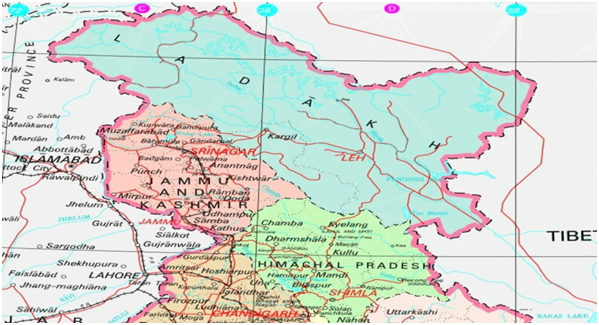
Temperature and Climate
Ladakh is a cold desert lying in the great Himalayas on the eastern side of Jammu and Kashmir. The Karakoram range in the North and the Zanskar mountain in the South, enclose it. Several rivers flow through Ladakh,Indus being the most important among them. Several glaciers are found in ladakh for example-The Gangri glacier.
The altitude in Ladakh varies from about 3000m in Kargil to more than 8000m in the Karakoram. Due to its high altitude, the climate remains extremely cold and dry. The air at this altitude is so thin that the heat of the sun can be felt intensely. The day temperatures in summer are just above zero degree and the night temperature well blows -300 C. It is freezing cold in the winters when the temperature may remain below -400 for most of the time. Ladakh lies in the rain shadow of the Himalayas, due to which it received little rainfall as low as 10 cm every year. The area experiences freezing winds and burning hot sunlight.
Ladakh is also known as Khapa-Chan, which means snow land.
Drass, one of the coldest inhabited places on Earth, is located in Ladakh.
Rainforest(Flora and fauna)
Due to high aridity, the vegetation is sparse. There are scanty patches of grass and shrubs for animals to graze.Groves of willows and poplars are seen in the valleys. During the summers, fruit trees such asapples, apricots and walnuts bloom.
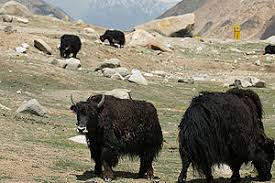
Robins, redstarts, Tibetan snowcock, raven and hoopoe are common. Some of these are migratory birds. The animals of Ladakh are wild goats, wild sheep, yak and special kind of dogs. The animals are reared to provide for the milk, meat and hides. Yak’s milk is used to make cheese and butter. The hair of the sheep and goat is used to make woolens.
The finest cricket bats are made from the wood of the willow trees.
The Chiru or the Tibetan antelope is an endangered species. It is hunted for its wool known as shahtoosh, which is light in weight and extremely warm.
People
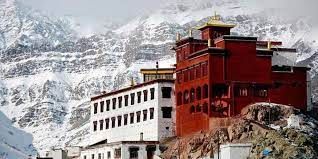
People of Ladakh are either Muslims or Buddhists. In fact, several Buddhist monasteries dot theLadakhi landscape with their traditional ‘gompas’. Some famous monasteries are Hemis, Thiksey, Shey and Lamayuru. In this summer season, the people are busy cultivating barly, potatoes, peas, beans and turnip. The climate in winter months so harsh that people keep themselves engaged in festivities and ceremonies. The women work not only in the house and fields, but also manage small business and shops.Leh, the capital of Ladakh is well connected both by road and air. National Highway 1Aconnects leh to Kashmir Valley through the Zojila Pass.
Tourism is a major activity with several tourist streaming in from within India and abroad. Visit to the gompas, tracks to see the meadows and glaciers, witnessing ceremonies andfestivities are important activities. Life of the people is undergoing change due to modernisation.
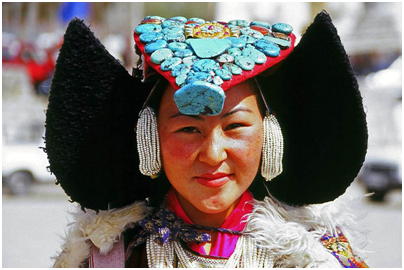
People of Ladakh over the centuries learned to live in balance and harmony with nature. Due to scarcity of resources like water and fuel, they are used with reverence and care. Nothind is discarded or wasted.
Manali Leh Highway crosses four passes,Rohtang la, Baralacha la, Lungalacha la and Tanglangla.
The highway opens only between July and September when snow is cleared from the road.

 Cognizance Publication
Cognizance Publication
